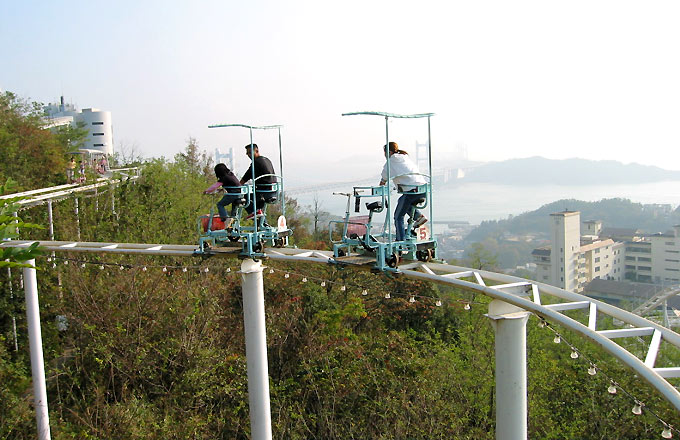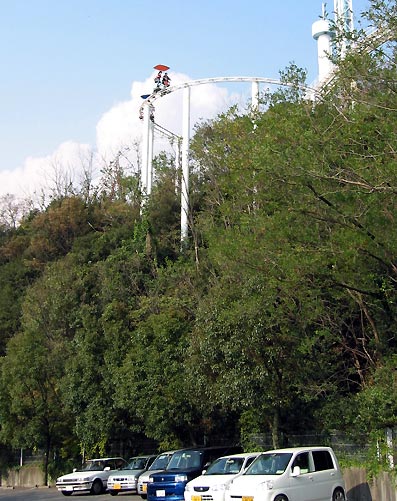The Electro-Kinetic Road Ramp, Environmentally Friendly Engineering
Lately we have been uber-enviro-nerds with the talk of wind turbines, deep lake cooling and environmentally friendly roller coasters. I just felt the need to put up another nifty energy saving device that was invented by a Bloke from the UK named Peter Hughes. He has created a ramp that absorbs kinetic energy from breaking or slowing down while driving your car over regular roadways. The idea is simple, use the cars wasted kinetic energy to power the streetlights and stoplights. There are a series of plates installed under the road which the cars will drive over, more than likely around stop lights or other areas where the traffic will be slowed. The weight of the car slightly shifts the plates, causing kinetic energy to be created. The energy is stored and then used to power whatever. It is better described on the official site, so I will just do you a favor and quote it here.
The ramp is unobtrusive, silent in operation, causes no discomfort to the vehicles occupants and is entirely safe in operation. The Ramp is designed to require the minimum of maintenance and may be used for generating electricity to power street lighting, traffic lights, road signs, with the surplus being fed into the national grid. It also has the capability to store electricity within a storage battery facility.I also found a video that you can watch that shows this in action. [youtube]uA0aiKFMSac[/youtube] I have high hopes for this technology; it is a very smart design and easily implemented for almost any roadway. The amount of energy spent operating the lights for roadways may not be much in comparison to other utilities we expect in our daily lives but this simple innovation will hopefully lead the way in other inventions to lessen our dependence on fossil fuels and ultimately reduce the amount of pollution because of this. I think this technology is only currently being implemented in the UK but hopefully American cities will become aware of this power creating device and take advantage of it's obvious benefits. Also, since America is the largest contributor to pollution world wide, it couldn't hurt to try to change the image for the better by fully embracing any new technology that could possibly make a worthwhile difference.
 The system, by
The system, by  Other large Great Lakes cities like Chicago, Cleveland, and Buffalo could take advantage of a system like this as well. Add in a few off-shore wind farms and the Rust Belt could take a real lead in green technology that makes use of the local geography. So what do you say, Cleveland?
Other large Great Lakes cities like Chicago, Cleveland, and Buffalo could take advantage of a system like this as well. Add in a few off-shore wind farms and the Rust Belt could take a real lead in green technology that makes use of the local geography. So what do you say, Cleveland?
 So, as you may or may not know, here at unsought we are really kind of environerds, some more than others. Either way, while stumbling on the internet I came across a page about an
So, as you may or may not know, here at unsought we are really kind of environerds, some more than others. Either way, while stumbling on the internet I came across a page about an  Basically the premise of this roller coaster is that you are pedaling instead of having it run off of gasoline or electricity. As you may or may not know,
Basically the premise of this roller coaster is that you are pedaling instead of having it run off of gasoline or electricity. As you may or may not know,  This ride is apparently located in a Japanese amusement park on the island of
This ride is apparently located in a Japanese amusement park on the island of  The Japanese writing on the picture says chiyupikosataa, the second part of that if you sound it out is coaster. From what I gathered from the site, the mascot of this amusement park is a mouse called Chiyupi, so this probably a coaster named after it.
I don't really think this will catch on with American audiences, but I know that if I go back to Japan, hopefully in October, that I will make it a point to try and find this park just to ride this ride. If I do, I will definitely write another article on this coaster with a first hand account of if it was really worth all the effort and fear. Until then, please enjoy the fantastic amusements that are located in your general vicinity.
The Japanese writing on the picture says chiyupikosataa, the second part of that if you sound it out is coaster. From what I gathered from the site, the mascot of this amusement park is a mouse called Chiyupi, so this probably a coaster named after it.
I don't really think this will catch on with American audiences, but I know that if I go back to Japan, hopefully in October, that I will make it a point to try and find this park just to ride this ride. If I do, I will definitely write another article on this coaster with a first hand account of if it was really worth all the effort and fear. Until then, please enjoy the fantastic amusements that are located in your general vicinity.
 One of the latest theories for the mass disappearance of bees recently has to do with cell phones.
One of the latest theories for the mass disappearance of bees recently has to do with cell phones.  know, it's hard to believe that it would be a big deal, and in fact, no one has really made a big stink about it yet. But it's important. Why, you might ask? Well, even if you didn't ask, you should probably read on since this topic definitely affects everyone, even if you don't like honey or bees.
Most people know that bees are responsible for honey and bee stings but what you may not know is that they are a much more important member of the agricultural community. Bees, especially honey bees, are responsible for the pollination of flowers (you might be saying duh, here but follow me on this one, please), and said pollination causes plants to actually bear fruits as the method of their reproduction. And said fruits are important for not only human nutrition, but also for that of most of the animals we raise as pets and most of the animals that we eat.
This topic came to my attention from my grandfather, an almost retired farmer. He brought it up to my mother in this manner.
Grandpa: "Hey, The Fidge (that's me, btw) is a biologist, right?"
Mom: "you know she is"
G: "Well, can she tell me why the lady down the road's bees are almost all dead?"
M: "Really? They are almost all dead? Why?"
G: " Well, if we knew, we wouldn't be asking The Fidge, would we? Of her 20 hives, only two of them are still alive. All of the other hives are dead. And the other guy down the road, he had 125 hives and now only maybe twenty of them are still alive. They asked me if I knew what was happening, and I said I would ask the Fidge."
So, this has become a job for me. Although I am just using the internet to research it, I do plan on calling a visit on these beekeepers to talk to them about their practices, but in the meantime I will fill you in on what the vast spaces of the interweb have to say about this little bee apocalypse.
First of all, officials are calling this epidemic Colony Collapse Disorder, or CCD for short. (I just would like to point out that everything needs an acronym.) This used to be called Fall Dwindle Disease (FDD) but it was changed b/c it was noticed that this is not due to seasonality, nor can it be ruled to just being a disease. Actually, most experts are baffled to what exactly CCD is. Basically, they can't narrow it down to what is really killing all the bees. For example, according to the
know, it's hard to believe that it would be a big deal, and in fact, no one has really made a big stink about it yet. But it's important. Why, you might ask? Well, even if you didn't ask, you should probably read on since this topic definitely affects everyone, even if you don't like honey or bees.
Most people know that bees are responsible for honey and bee stings but what you may not know is that they are a much more important member of the agricultural community. Bees, especially honey bees, are responsible for the pollination of flowers (you might be saying duh, here but follow me on this one, please), and said pollination causes plants to actually bear fruits as the method of their reproduction. And said fruits are important for not only human nutrition, but also for that of most of the animals we raise as pets and most of the animals that we eat.
This topic came to my attention from my grandfather, an almost retired farmer. He brought it up to my mother in this manner.
Grandpa: "Hey, The Fidge (that's me, btw) is a biologist, right?"
Mom: "you know she is"
G: "Well, can she tell me why the lady down the road's bees are almost all dead?"
M: "Really? They are almost all dead? Why?"
G: " Well, if we knew, we wouldn't be asking The Fidge, would we? Of her 20 hives, only two of them are still alive. All of the other hives are dead. And the other guy down the road, he had 125 hives and now only maybe twenty of them are still alive. They asked me if I knew what was happening, and I said I would ask the Fidge."
So, this has become a job for me. Although I am just using the internet to research it, I do plan on calling a visit on these beekeepers to talk to them about their practices, but in the meantime I will fill you in on what the vast spaces of the interweb have to say about this little bee apocalypse.
First of all, officials are calling this epidemic Colony Collapse Disorder, or CCD for short. (I just would like to point out that everything needs an acronym.) This used to be called Fall Dwindle Disease (FDD) but it was changed b/c it was noticed that this is not due to seasonality, nor can it be ruled to just being a disease. Actually, most experts are baffled to what exactly CCD is. Basically, they can't narrow it down to what is really killing all the bees. For example, according to the